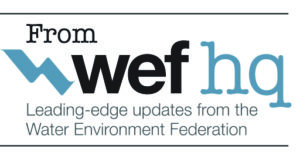 The Water Environment Federation (WEF) is an avid supporter of innovation in the water sector. In fact, one of WEF’s critical objectives is to “establish the conditions that promote accelerated development and implementation of innovative technologies and approaches.”
The Water Environment Federation (WEF) is an avid supporter of innovation in the water sector. In fact, one of WEF’s critical objectives is to “establish the conditions that promote accelerated development and implementation of innovative technologies and approaches.”
As part of this initiative, WEF and The Water Research Foundation (WRF) jointly created the Leaders Innovation Forum for Technology (LIFT) program more than 5 years ago to help facilitate the adoption of water technologies and move innovation into practice.
For the newest addition to LIFT, WEF is coordinating a nationwide network of Water Technology Innovation Clusters, which were originally developed by the U.S. Environmental Protection Agency (EPA). The clusters program will be run as a LIFT focus group led by Bryan Stubbs, executive director of the Cleveland Water Alliance, and Aayushi Jain, market transformation associate for the Los Angeles Cleantech Incubator.
What are water clusters?
Water Technology Innovation Clusters are regional groupings of businesses, government, research institutions, and other organizations focused on innovative technologies to provide clean and reliable water. WEF will facilitate cluster communications, advise cluster organizations, enable collaboration among clusters, and identify water programs that support cluster activities.
Clusters have a key role to play in addressing the nation’s pressing water issues.
* Spur innovation. Clusters create a situation where companies and organizations can easily share ideas and solutions.
* Accelerate the development of new technologies. Connections within clusters lead to partnerships between businesses and researchers, facilitating the transfer of new technologies to the market.
* Streamline the adoption of new technologies. Clusters provide companies with easier access to test beds and partners for pilot studies and encourage communication among companies and regulators.
Building on past efforts
While the program is a new addition to LIFT, the clusters have been involved in WEF’s Technical Exhibition and Conference (WEFTEC). For the last several years, the Water Technology Innovation Clusters, under the auspices of EPA, had a formal meeting at WEFTEC and have been showcased in several sessions within the WEFTEC Innovation Pavilion.
In 2017, cluster leaders from the New England Water Innovation Network (NEWIN), Current, The Water Council, and the Los Angeles Cleantech Incubator participated in a lively panel discussion titled “How can I benefit from a water innovation cluster?” Panelists talked about how clusters support pilot projects, foster collaboration among utilities and universities, and link entrepreneurs with advisors and customers.
Also at WEFTEC 2017, an Innovation Pavilion session, titled “The Water Council’s BREW (Business – Research – Entrepreneurship – in Wisconsin) Accelerator,” held a business-pitching session modeled after the successful show “Shark Tank.” BREW participant companies pitched for 3 to 5 minutes, after which a panel grilled them about their business model, technology, intellectual property, marketing strategy, and more. Nothing was off limits in these lightning fast pitches.
In a third session, the Cleveland Water Alliance discussed the Erie Hack, which is Lake Erie’s first water innovation competition. The Cleveland Water Alliance partnered with DigitalC, a civic tech collaboration organization to hold this competition. The Erie Hack brought together more than 100 partner organizations and 200 participants — coders, developers, engineers, data experts, and water professionals — from nearly every major city around the lake to work on its greatest challenges, especially harmful algal blooms.
As a follow-up to the Erie Hack, the Cleveland Water Alliance branched out into another water innovation competition, the Internet of H2O Challenge. This competition seeks to leverage next-generation networking and sensor technology to monitoring and managing nutrients in Lake Erie and beyond. The goal was to generate robust and resilient nutrient monitoring pilots with the potential to scale across the Great Lakes. The alliance partnered with DigitalC as well as US Ignite, which spurs the creation of next-generation applications and smart cities, and the National Science Foundation. Other participants include the Great Lakes Observing System, IBM, City of Sandusky, Bowling Green State University, Heidelberg University, AT&T, U.S. EPA, Great Lakes Commission, NOAA, Limnotech, and others to focus the Erie Hack’s energy on developing a resilient monitoring system for nutrients.
Moving innovation forward
Water Technology Innovation Clusters are uniquely making a difference at a local and regional level. Even though each cluster is a separate entity located in various regions, this overall program brings together the cluster leaders so that they can work on a larger national scale.
For example, the cluster leaders previously have worked together to produce such reports as Overcoming Barriers to Water Innovation in the U.S. and Building a Successful Technology Cluster. These resources are beneficial not only to existing clusters, but also to those seeking to create a cluster in their region.
WEF is excited to take on this program set up by EPA and to continue to build valuable innovative programs for our members through LIFT and the WEFTEC Innovation Pavilion. For more information on the Water Technology Innovation Clusters program visit www.wef.org/techclusters.